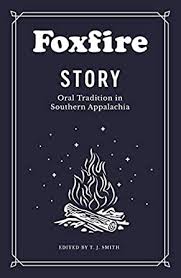Foxfire is bioluminescence from fungi decaying on wood. Although it has been viewed as a phenomenon most prevalent in the Southern Appalachians and thus a kind of symbol for the region, it occurs world-wide. The oldest written documentation of it was by Aristotle, and it figures in Japanese folklore. The Foxfire Fund is a multi-million-dollar enterprise headquartered in Rabun County, Georgia’s most northeastern county. Eliot Wigginton started developing it when he was teaching at the Rabun Gap-Nacoochee School in 1966 and sought a way to get his English students to care about his subject. He hit upon the idea of getting them to interview old people in their area who were living in old-fashioned ways. Fortunately, Aunt Arie and Kenny Runyan and others turned out to be downright charismatic practitioners of the old ways, and in 1967 his students began publishing a magazine they called Foxfire. Students cared about learning English composition when they knew their kinfolks and neighbors would read the words they wrote. Some of their magazine articles were published in The Foxfire Book in 1972, and it sold half a million copies in its first six months. Other books followed before and after 1977 when Wigginton began teaching in the county’s public high school. From the beginning, Wigginton made sure that all the profits from his enterprises went into the non-profit Foxfire Fund, and it set up a museum that now holds 110 acres and 31 log structures and buildings to provide a plethora of educational resources. In 1992 Eliot Wigginton pleaded guilty to child molestation and was sentenced to a year in the county jail and required to register as a sex offender and to never teach or interact with children again. He moved to Florida and started a company creating lawn ornaments, a profession his father had followed. Despite this huge set-back, the decision was made to continue the Foxfire Fund using the same name it had for twenty-five years, and it has thrived with an annual festival, summer jobs for high school kids, and other programs. And the books continued to be published by local students and their teachers and advisors eventually including twelve Foxfire Books and ten other books exploring particular topics. Nevertheless, much writing has been collected by the students that has never been published. This book combines archival and new material. It has two sections, “The Stories” and “The Tellers.” The eight “story” chapters begin with a chapter on mountain speech and then look at a different kind of stories, from proverbs to songs to pranks. The seven “teller” chapters each feature a different storyteller, including one woman and two Cherokee men. The editor, T. J. Smith is the Executive Director of the Foxfire Fund.
New York: Anchor/Penguin Random House, 2020. 299 pages with a Foreword by John A. Burrison and photos. Trade paperback.
